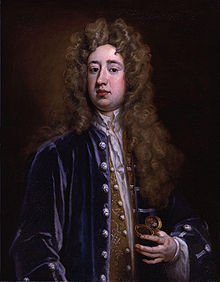- Charles Mohun, 4th Baron Mohun
-
Charles Mohun, 4th Baron Mohun (c. 1675 – 15 November 1712) was an English politician best known for his frequent participation in duels and his reputation as a rake.
Mohun was the second child of Charles, 3rd Baron Mohun and his wife Philippa, daughter of Arthur Annesley, 1st Earl of Anglesey.[1] His father died shortly after his birth, following a duel, and left him the family estate. The estate, however, was heavily in debt. Due to this Mohun received no education, and was forced to resort to gambling in order to support his lavish lifestyle.
Mohun married Charlotte Orby, granddaughter of Charles Gerard, 1st Earl of Macclesfield, in 1691[1] with the hope that this match would alleviate some of his debt. Unfortunately he received no dowry for the marriage, and the couple separated shortly thereafter. Following the separation, Mohun's behaviour became ever more licentious. A gambling dispute in late 1692 resulted in his first duel, with John Kennedy, 7th Earl of Cassilis. But Mohun is best remembered for the events of 9 December of that year—a friend of Mohun's, an officer named Richard Hill, had fallen in love with the actress Anne Bracegirdle; however he thought himself, almost certainly erroneously, to face competition from actor William Mountfort. Mohun and Hill ambushed the actor after a performance and, whilst Mohun restrained him—or by some eyewitness accounts stood by watching—Hill stabbed him through the chest. Following Mountfort's death the next day, Hill fled the country, Mohun was captured and tried by the House of Lords. However, in a verdict that was widely condemned, Mohun was acquitted on 6 February 1693.
Mohun joined the army shortly after his acquittal. There he served under Charles Gerard, 2nd Earl of Macclesfield, the uncle of his former wife, and briefly served in France. In 1697 Mohun was again tried by the Lords for murder following a duel on Leicester Square. Mohun was again acquitted, although his friend Edward Rich, 6th Earl of Warwick was found guilty of manslaughter. After this incident Mohun took his seat in the House of Lords. In 1701 he accompanied the Earl of Macclesfield on a diplomatic mission to Hanover. Following the death of Macclesfield later in the year, Mohun was left most of his estate. He went on to spend over a decade defending his inheritance from rival claimants, most famously James Douglas, 4th Duke of Hamilton. In 1707 he became a member of the Kit-Cat Club, the pre-eminent Whig political and literary association of the period. Also in 1707 Mohun began building his new country house, Gawsworth New Hall.
In 1712, two years after Mohun's Whig party had been heavily defeated in an election, the Duke of Hamilton was given the post of special envoy to Paris. Also at this time Mohun's legal dispute with Hamilton over his inheritance of the Macclesfield estate was going badly. Shortly before Hamilton left for France, Mohun challenged him to a duel which was fought on 15 November in Hyde Park. Hamilton was killed during the fight by Mohun's second, George MacCartney, after he had mortally wounded Mohun during the duel; Mohun died from his wounds shortly afterwards. This bloody duel was made immortal by William Makepeace Thackeray in his novel The History of Henry Esmond. The injuries suffered by the two men were so horrific that the government passed legislation banning the use of seconds in such duels. Also as a result swords were replaced as the weapons of choice in duel by the pistol, which tended to result in shorter and less bloody fights.
Footnotes
- ^ a b Kiernan, V. G. (October 2005). "Mohun, Charles, fourth Baron Mohun (1675?–1712)". Oxford Dictionary of National Biography. Oxford University Press. doi:10.1093/ref:odnb/18881. http://www.oxforddnb.com/view/article/18881. Retrieved 2 January 2011. Subscription or UK public library membership required
References
- Andrew, Donna (1980). "The code of honour and its critics : the opposition to duelling in England, 1700-1850" in Social History 5.3.
- Forsythe, Robert S. (1928). A Noble Rake: the life of Charles, fourth lord Mohun; being a study in the historical background of Thackeray's "Henry Esmond". Cambridge, Mass, Harvard University Press.
- Kiernan, V.G. (1989). The duel in European history: honour and the reign of aristocracy. Oxford, Oxford University Press. ISBN 0-19-285128-4
- Stater, Victor (1999). Duke Hamilton Is Dead!: A Story of Aristocratic Life and Death in Stuart Britain London, Hill & Wang, ISBN 0-8090-4033-6.
- Stater, Victor (2000). High Life, Low Morals: The Duel that Shook Stuart Society. Pimlico.
Peerage of England Preceded by
Charles MohunBaron Mohun
2nd creation
1677–1712Extinct Categories:- Barons in the Peerage of England
- Duelling fatalities
- 1675 births
- 1712 deaths
Wikimedia Foundation. 2010.

